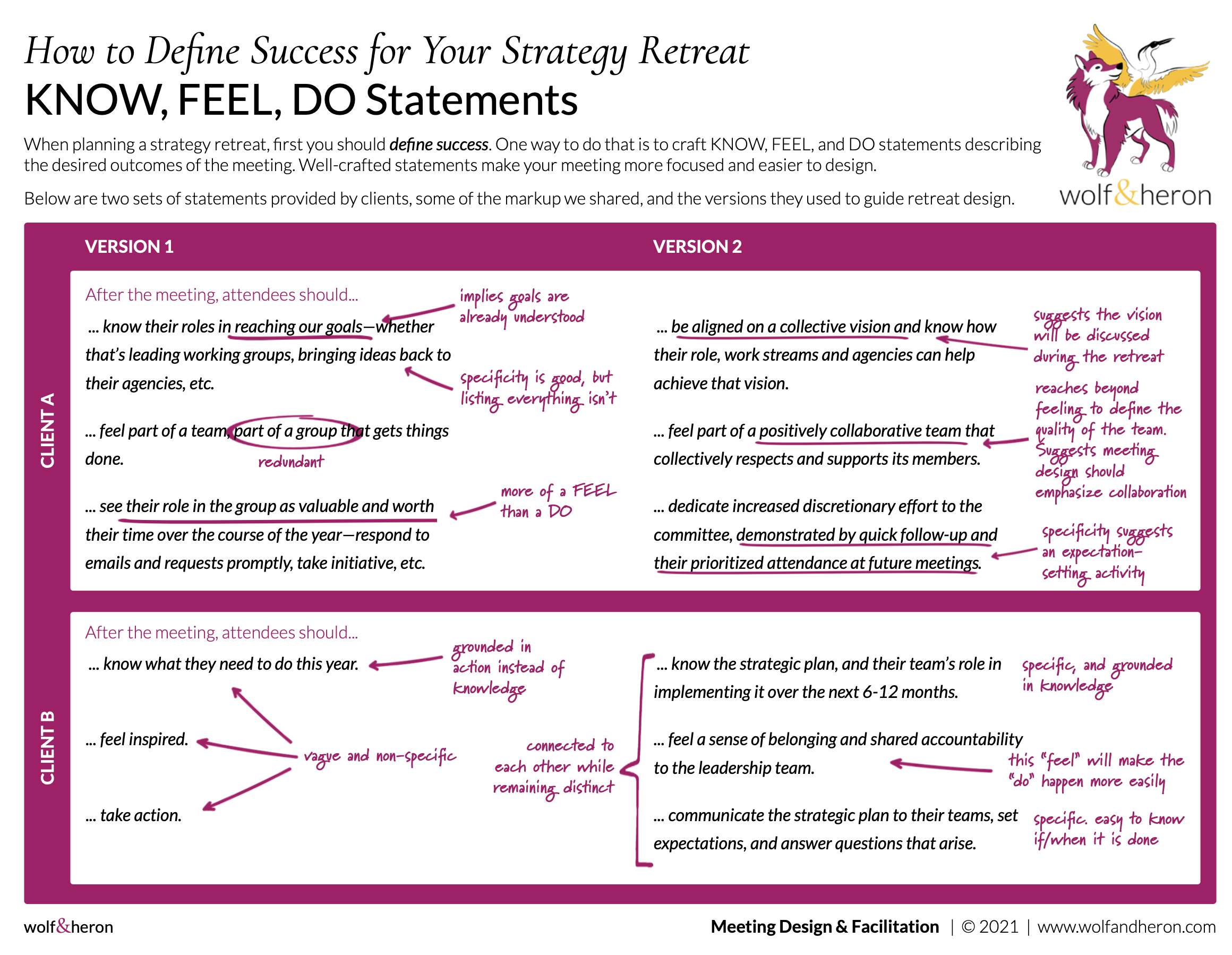Plan the Best Strategy Retreat of Your Career: Series Summary
Over the past several weeks, we posted a series of articles that walk you step by step through planning and facilitating the best strategy retreat of your career. Each week, we focused on one critical piece of the process we follow with our clients to ensure they design their meetings effectively and facilitate them for success.
PART 1: DEFINE SUCCESS
The most important thing you need to do once you’ve broadly identified the need for a strategy retreat is to define success. There are a few ways to do this, but the crux of this step is to make sure you and your team are aligned on the “why” for the retreat. Why is it happening? Why should people show up? Why should they care? Why should they contribute? Don’t just focus on the routine… we’re meeting because that’s what we do every year. Instead, aim to uncover why this retreat specifically needs to happen this time, this year. Although you may already have a cursory idea of agenda topics, this step should take you beyond thinking about “what” you’re doing, and bring focus and sophistication to your meeting design. Read the article to understand how to establish a strong purpose for your meeting.
Downloadable resource: How to Define Success for Your Strategy Retreat: Craft Know, Feel, Do Statements
PART 2: DEVELOP A STRAW MAN AGENDA
If you’ve done your homework and your planning committee has aligned on the KNOW, FEEL, and DO objectives for your strategy retreat, the next step is developing an agenda. Open the planning document with your refined KNOW, FEEL and DO statements. Below them, make a table with 5 columns and label them with these headings:
KNOW, FEEL, & DO | LEAD | CONTRIBUTORS | TIME | ACTIVITY
Think about the journey your participants need to go on over the course of the retreat, and build out a row in your table for each step of that journey. Determine what they need to KNOW, FEEL, and DO first, second, third, and so on. Each row will be its own experience or agenda item, and each should have its own distinct purpose. Then, fill in the rest of the columns. Read the article for red flags to pay attention to when developing your straw man agenda.
Downloadable resources: Two marked up draft agendas with our feedback
PART 3: DESIGN YOUR ACTIVITIES TO ENGAGE YOUR ATTENDEES
Now it’s time to get precise on each element of the agenda with an eye for how you will make it (actually) engaging. With our clients, we often see the default is to rely on leaders’ presentations and accompanying slide decks to carry the entire meeting. We see meeting coordinators and individual presenters focusing heavily on WHAT they plan to communicate, and less on HOW they plan to communicate it, explore it and make collective decisions based on it.
Truly engaging your audience takes a lot more effort and planning and, as a result, is often neglected. Even when planning committees make the choice to hold engagement and interactivity central to their design, the best they often come up with is a leader-led discussion followed by an “interactive Q&A” with everyone else.
Engaging your attendees properly not only makes the meeting more stimulating for everyone, it creates a more productive discussion with more diverse viewpoints and greater overall buy-in. How you choose to engage attendees should be informed by the constraints of each individual agenda item. Check out the article for several rules of thumb to help you think about your activity design.
Downloadable resources: Materials for Meeting Success and Ramp Up The Asks
PART 4: NAVIGATE DAY-OF CHALLENGES
It’s showtime! You’ve done the work to intentionally set up your meeting for success, but there are some things you just can’t do in advance. The article includes some tips to help you navigate (and avoid!) day-of challenges that may arise.
Downloadable resource: Ground Rules for Success
What did you think of this series? We'd love your feedback on the articles and downloadable resources, plus ideas for future posts.





